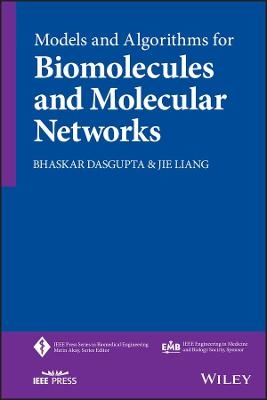
Models and Algorithms for Biomolecules and Molecular Networks
Wiley-IEEE Press (Verlag)
978-0-470-60193-8 (ISBN)
By providing expositions to modeling principles, theories, computational solutions, and open problems, this reference presents a full scope on relevant biological phenomena, modeling frameworks, technical challenges, and algorithms.
Up-to-date developments of structures of biomolecules, systems biology, advanced models, and algorithms
Sampling techniques for estimating evolutionary rates and generating molecular structures
Accurate computation of probability landscape of stochastic networks, solving discrete chemical master equations
End-of-chapter exercises
BHASKAR DASGUPTA is a Professor in the Computer Science department at the University of Illinois at Chicago, USA. He has written numerous bioinformatics research papers. Dr. DasGupta was the recipient of the NSF CAREER award in 2004 and the UIC College of Engineering Faculty Teaching award in 2012. JIE LIANG is the Richard and Loan Hill Professor within the Department of Bioengineering and Department of Computer Science at the University of Illinois at Chicago, USA. He earned his Ph.D. in Biophysics. He was an NSF CISE postdoctoral research associate (1994-1996) at the Beckman Institute and National Center for Supercomputing and its Applications (NCSA), as well as a visiting fellow at the NSF Institute of Mathematics and Applications at Minneapolis. He was a recipient of the NSF CAREER award in 2003. He was elected a fellow of the American Institute of Medicine and Biological Engineering in 2007. He was a University Scholar (2010-2012).
List of Figures xiii
List of Tables xix
Foreword xxi
Acknowledgments xxiii
1 Geometric Models of Protein Structure and Function Prediction 1
1.1 Introduction 1
1.2 Theory and Model 2
1.2.1 Idealized Ball Model 2
1.2.2 Surface Models of Proteins 3
1.2.3 Geometric Constructs 4
1.2.4 Topological Structures 6
1.2.5 Metric Measurements 9
1.3 Algorithm and Computation 13
1.4 Applications 15
1.4.1 Protein Packing 15
1.4.2 Predicting Protein Functions from Structures 17
1.5 Discussion and Summary 20
References 22
Exercises 25
2 Scoring Functions for Predicting Structure and Binding of Proteins 29
2.1 Introduction 29
2.2 General Framework of Scoring Function and Potential Function 31
2.2.1 Protein Representation and Descriptors 31
2.2.2 Functional Form 32
2.2.3 Deriving Parameters of Potential Functions 32
2.3 Statistical Method 32
2.3.1 Background 32
2.3.2 Theoretical Model 33
2.3.3 Miyazawa--Jernigan Contact Potential 34
2.3.4 Distance-Dependent Potential Function 41
2.3.5 Geometric Potential Functions 45
2.4 Optimization Method 49
2.4.1 Geometric Nature of Discrimination 50
2.4.2 Optimal Linear Potential Function 52
2.4.3 Optimal Nonlinear Potential Function 53
2.4.4 Deriving Optimal Nonlinear Scoring Function 55
2.4.5 Optimization Techniques 55
2.5 Applications 55
2.5.1 Protein Structure Prediction 56
2.5.2 Protein--Protein Docking Prediction 56
2.5.3 Protein Design 58
2.5.4 Protein Stability and Binding Affinity 59
2.6 Discussion and Summary 60
2.6.1 Knowledge-Based Statistical Potential Functions 60
2.6.2 Relationship of Knowledge-Based Energy Functions and Further Development 64
2.6.3 Optimized Potential Function 65
2.6.4 Data Dependency of Knowledge-Based Potentials 66
References 67
Exercises 75
3 Sampling Techniques: Estimating Evolutionary Rates and Generating Molecular Structures 79
3.1 Introduction 79
3.2 Principles of Monte Carlo Sampling 81
3.2.1 Estimation Through Sampling from Target Distribution 81
3.2.2 Rejection Sampling 82
3.3 Markov Chains and Metropolis Monte Carlo Sampling 83
3.3.1 Properties of Markov Chains 83
3.3.2 Markov Chain Monte Carlo Sampling 85
3.4 Sequential Monte Carlo Sampling 87
3.4.1 Importance Sampling 87
3.4.2 Sequential Importance Sampling 87
3.4.3 Resampling 91
3.5 Applications 92
3.5.1 Markov Chain Monte Carlo for Evolutionary Rate Estimation 92
3.5.2 Sequentail Chain Growth Monte Carlo for Estimating Conformational Entropy of RNA Loops 95
3.6 Discussion and Summary 96
References 97
Exercises 99
4 Stochastic Molecular Networks 103
4.1 Introduction 103
4.2 Reaction System and Discrete Chemical Master Equation 104
4.3 Direct Solution of Chemical Master Equation 106
4.3.1 State Enumeration with Finite Buffer 106
4.3.2 Generalization and Multi-Buffer dCME Method 108
4.3.3 Calculation of Steady-State Probability Landscape 108
4.3.4 Calculation of Dynamically Evolving Probability Landscape 108
4.3.5 Methods for State Space Truncation for Simplification 109
4.4 Quantifying and Controlling Errors from State Space Truncation 111
4.5 Approximating Discrete Chemical Master Equation 114
4.5.1 Continuous Chemical Master Equation 114
4.5.2 Stochastic Differential Equation: Fokker—Planck Approach 114
4.5.3 Stochastic Differential Equation: Langevin Approach 116
4.5.4 Other Approximations 117
4.6 Stochastic Simulation 118
4.6.1 Reaction Probability 118
4.6.2 Reaction Trajectory 118
4.6.3 Probability of Reaction Trajectory 119
4.6.4 Stochastic Simulation Algorithm 119
4.7 Applications 121
4.7.1 Probability Landscape of a Stochastic Toggle Switch 121
4.7.2 Epigenetic Decision Network of Cellular Fate in Phage Lambda 123
4.8 Discussions and Summary 127
References 128
Exercises 131
5 Cellular Interaction Networks 135
5.1 Basic Definitions and Graph-Theoretic Notions 136
5.1.1 Topological Representation 136
5.1.2 Dynamical Representation 138
5.1.3 Topological Representation of Dynamical Models 139
5.2 Boolean Interaction Networks 139
5.3 Signal Transduction Networks 141
5.3.1 Synthesizing Signal Transduction Networks 142
5.3.2 Collecting Data for Network Synthesis 146
5.3.3 Transitive Reduction and Pseudo-node Collapse 147
5.3.4 Redundancy and Degeneracy of Networks 153
5.3.5 Random Interaction Networks and Statistical Evaluations 157
5.4 Reverse Engineering of Biological Networks 159
5.4.1 Modular Response Analysis Approach 160
5.4.2 Parsimonious Combinatorial Approaches 166
5.4.3 Evaluation of Quality of the Reconstructed Network 171
References 173
Exercises 178
6 Dynamical Systems and Interaction Networks 183
6.1 Some Basic Control-Theoretic Concepts 185
6.2 Discrete-Time Boolean Network Models 186
6.3 Artificial Neural Network Models 188
6.3.1 Computational Powers of ANNs 189
6.3.2 Reverse Engineering of ANNs 190
6.3.3 Applications of ANN Models in Studying Biological Networks 192
6.4 Piecewise Linear Models 192
6.4.1 Dynamics of PL Models 194
6.4.2 Biological Application of PL Models 195
6.5 Monotone Systems 200
6.5.1 Definition of Monotonicity 201
6.5.2 Combinatorial Characterizations and Measure of Monotonicity 203
6.5.3 Algorithmic Issues in Computing the Degree of Monotonicity 𝖬 207
References 209
Exercises 214
7 Case Study of Biological Models 217
7.1 Segment Polarity Network Models 217
7.1.1 Boolean Network Model 218
7.1.2 Signal Transduction Network Model 218
7.2 ABA-Induced Stomatal Closure Network 219
7.3 Epidermal Growth Factor Receptor Signaling Network 220
7.4 C. elegans Metabolic Network 223
7.5 Network for T-Cell Survival and Death in Large Granular Lymphocyte Leukemia 223
References 224
Exercises 225
Glossary 227
Index 229
| Reihe/Serie | IEEE Press Series on Biomedical Engineering |
|---|---|
| Zusatzinfo | Drawings: 40 B&W, 0 Color |
| Sprache | englisch |
| Maße | 158 x 236 mm |
| Gewicht | 476 g |
| Themenwelt | Naturwissenschaften ► Biologie ► Biochemie |
| Technik ► Umwelttechnik / Biotechnologie | |
| ISBN-10 | 0-470-60193-0 / 0470601930 |
| ISBN-13 | 978-0-470-60193-8 / 9780470601938 |
| Zustand | Neuware |
| Informationen gemäß Produktsicherheitsverordnung (GPSR) | |
| Haben Sie eine Frage zum Produkt? |
aus dem Bereich


